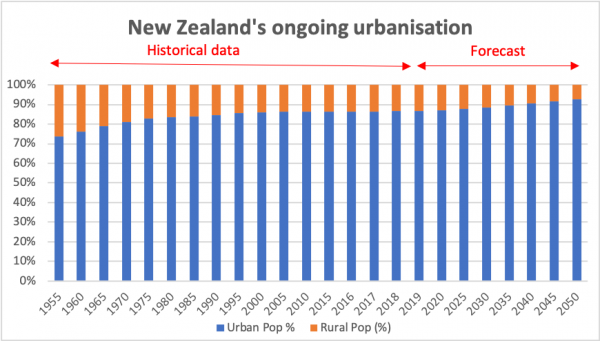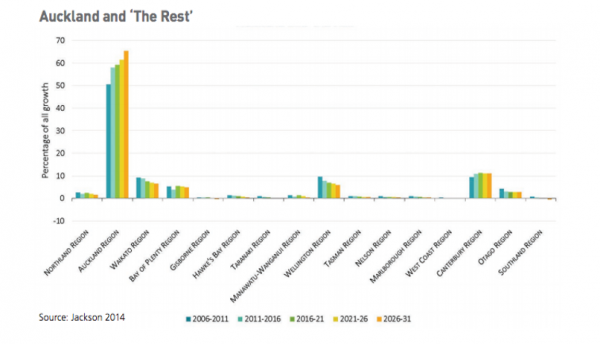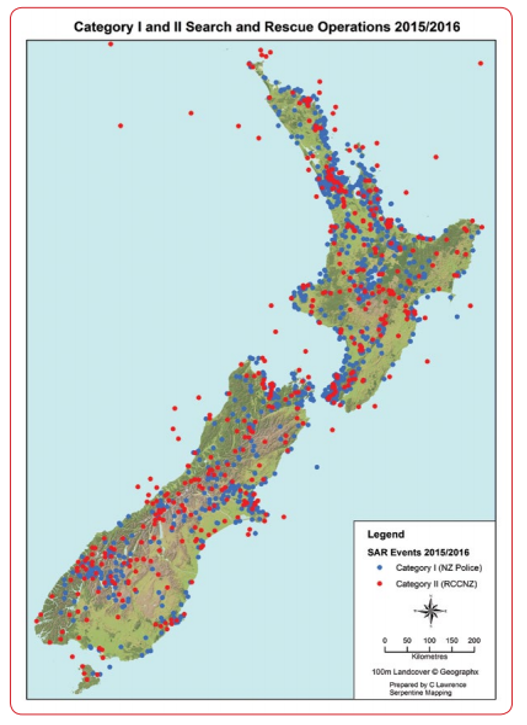Urbanisation
Page updated: 28 December 2020
Urbanisation relates to the tendency for increased numbers of people to move out of rural settings and start living in larger urban centres like cities.
Urbanisation is a long term trend for New Zealand
Urbanisation has been a remarkably stable feature of New Zealand’s population change over the past 60+ years, and is projected to continue through 2050.
Of the total New Zealand population, 86% live in urban environments. Population growth is predicted to slow or end in most rural areas.
Between 1996 and 2018, the proportion of New Zealand's population living in major urban areas increased by 8 per cent. By contrast, the proportion living in rural settlements dropped 25 per cent (New Zealand Herald 2019).
COVID-19 notwithstanding, forecasts by Statistics NZ have suggested that this trend towards urbanisation is likely to continue.

New Zealand's Ongoing Urbanisation
Auckland is growing much faster than the rest of NZ
It has been predicted that Auckland will continue to have the largest share of the population growth in the foreseeable future.
More than half of New Zealand’s population growth between 2013 and 2043 is forecast to be in Auckland[i] and it is expected to reach 2 million people by 2033.[ii]

---
[i] “Future of Sport in New Zealand.” Sport NZ Sport and Recreation Knowledge Library, Sport NZ, 13 Apr. 2015, www.srknowledge.org.nz/research-completed/future-of-sport-in-new-zealand/.
[ii] “Future of Sport in New Zealand.” Sport NZ Sport and Recreation Knowledge Library, Sport NZ, 13 Apr. 2015, www.srknowledge.org.nz/research-completed/future-of-sport-in-new-zealand/.
The future population outside Auckland looks reasonably static
The percentage of the population living outside of Auckland is projected to be static or decline over the next 30 years.
Outside of Auckland, the rest of the north island is projected to increase by just 0.6 per cent a year from 2013 to 2043.[i] While 15 of New Zealand’s 16 regions will increase in population over this time, 17 Territorial Authorities will actually have fewer births, and deaths will outnumber births in three-fifths of territorial areas by 2043.
This is not to say that the rural centres will not grow at all, but rather that the rate of their growth is projected to be up to three times slower than that of major urban areas. For example, over 2017 and 2018, all of the main urban centres continued to grow while West Coast was the only region where GDP decreased (Statistics NZ 2019). Statistics NZ also forecasts that rural centres will continue growing by an average of just 11%, compared to 37% in the main urban areas out to 2043.

Growth rates in urban vs rural areas of NZ (Statistics NZ)
[i] “Water Safety New Zealand.” Water Safety Sector Strategy 2020 | Water Safety New Zealand, www.watersafety.org.nz/our-sector/water-safety-sector-strategy-2020/
Urbanisation is unlikely to impact SAR demand much
It is unlikely that urbanisation will have much real impact on the overall demand for SAR services.
This is because while people are increasingly living in urban areas, as their cell phones reveal: they still choose to travel to spend time outdoors.[i]
We can also see this through the data on the distribution of SAR operations (below), which are distributed around the country. While urbanisation means people live in cities, they still spend a lot of time out of them in the outdoors all around the country.

Source: NZSAR Annual Report, March 2016
However, one impact that population concentration in urban centres may have is on the supply of SAR services for regional or rural areas. This is explored more in the section on volunteering.
---
